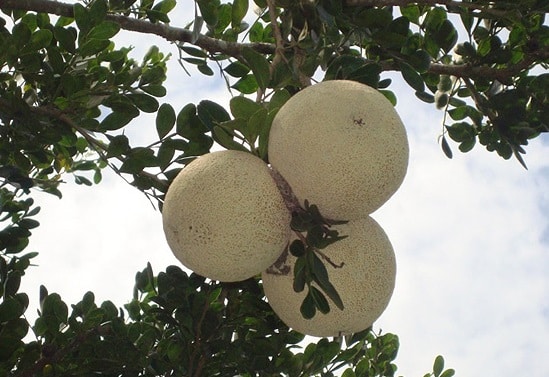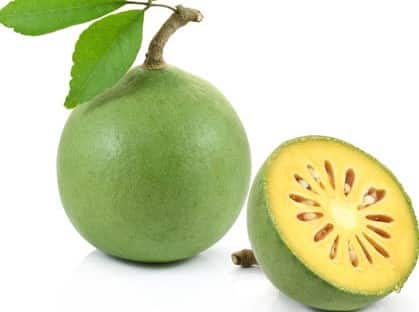Introduction of Wood Apple Farming:- Wood Apple is one of the edible fruits native to India and parts of Bangladesh, Pakistan, Sri Lanka and southeast Asia east to Java. These fruits are grown throughout India and can be cultivated along both peninsulas of the country. These plants can survive in dry regions with minimum water requirement. Wood apple has excellent health benefits along with some religious use. Most of the people grow as side crop by planting on borders. Wood apple is not cultivated as commercial crop in India. However, Maharashtra grows some of the larger, sweeter varieties on large scale. Currently, wood apple is also grown in Thailand, Malaysia, Cambodia, and other parts of Southeast Asia. Farmers in dry regions with less rainfall can opt for this crop. Wood apple belongs to genus of “Limonia” in the family “Rutaceae”. When it comes to its plant and fruit description, wood apple or Limonia acidissima is a large tree with long leaves, a hard berry fruit and an inner sticky brown pulp. The wood apple fruit is round to oval, 5-12 cm wide, with a hard, woody, grayish-white, scurfy rind about 6 mm thick. These trees can be grown in any waste lands or back yards. In south India, this fruit has significant religious importance in Ganesh chaturthi. Bael leaves are used as sacred offering to ‘Lord Shiva’. Some people use them for culinary (cooking) purpose as well.

Family Name of Wood Apple:- Rutaceae.
Botanical/Scientific Name of Wood Apple:- Limonia acidissima.
Uses and Health Benefits of Wood Apple (Bael Fruit):- The following are health benefits and uses of wood apple or Bael. Fruit or leaves both have excellent health benefits. This can be used in the form of juice, leaves or fruit (fresh and raw).
Parts used: roots, leaves, fruits.

- Wood apple cures digestive problems.
- Wood apple provides relief from gastric ulcers.
- Wood apple removes body toxins.
- Wood apple boosts energy level.
- Wood apple boosts metabolism.
- Wood apple is good for pregnant women.
- Wood apple controls diabetes.
- Wood apple prevents from liver disorders.
- Wood apple is good for skin and hair health.
- Wood apple cures indigestion and constipation.
- Wood apple controls blood pressure.
- Wood apple/Bael leaves relieve joint pain and swelling.
- Wood apple/Bael leaves cure Jaundice.
Common Names of Wood Apple in India:- Kavat, kurd apple, stone apple, elephant apple, and monkey fruit.
Local Names of Wood Apple in India:- Wood Apple (English), Kaitha (Hindi), Belada Hannu / Byalada Hannu (Kannada), Vellaga Pandu (Telugu), Vialm Pazham (Tamil), Vilathikka (Malayalam), Koth Bel (Bengali), Kaitha (Gujarati), Kavath (Marathi), Kapittha (Sanskrit).
Varieties of Wood Apple:- Not many varieties are available. However, there are two forms, one with large, sweetish fruits and other one with small, acid fruits.
Climate Requirement for Wood Apple Farming:- Due to hardy nature, wood apple trees have a wide adaptability to various climatic conditions. These trees require subtropical climate where summer is hot and dry, and winter is mild. The wood apple tree grows up to an elevation of 1,500 feet in the western Himalayas. These trees require a monsoon climate with a distinct dry season.
Soil Requirement of Wood Apple Farming:- Wood apple or Bael trees can thrive in wide range of soils. However, A well- drained, light sandy loam soil is ideal for its growth and fruit yield. One can supplement farm yard manure for better yield.
Land Preparation for Wood Apple Farming:- Land should be prepared in such a way that there won’t be any water stagnation in the filed as plants are most susceptible to water logging. Remove any weeds from previous crops.
Propagation in Wood Apple Farming:- The wood apple is generally propagated through seeds though seedlings will not bear fruits until at least 15 years of age. Multiplication may also be done by root cuttings, air-layers, or by budding onto self-seedlings to induce dwarfing and precociousness.
Planting, Season and Spacing in Wood Apple Farming:- Wood apple plants require a distance of 8 meter x 8 meter in case of Budded plants and requires 10 meter x 10 meter in case of seedlings (propagation from seeds). As part of land preparation, it needs pits of 80-90 cm x 80-90 cm x 80-90cm and these pits should be filled with a mixture of top soil + 20-25 kg of farmyard manure (FMY) and 50 grams gamma BHC up to a level of 6 cm from the ground level. In order to settle down the pits, light irrigation should be carried out. In India, the season for planting wood apple is from February-March or July-August.
Training/Pruning in Wood Apple Farming:- In early stages wood apple plants should be trained to build solid framework/structure with the help of stakes. As part of training, remove the tip of main stem when the tree is about 1 meter height. It is good practice of training to select only 5 to 6 well-spaced branches of wood apple tree. Normally, there is no need of pruning to be carried out. However, any diseased, dead or sick branches should be pruned off.
Irrigation in Wood Apple Farming:- Though these trees require less water, it is mandatory to provide water for better growth and yield of fruit. Basin ring system or drip system can be used in irrigation methods. Young plants of wood apple require good amount of water especially right after Manuring and fertigation. These plants don’t require any water in rainy season and once in a month after the monsoon. In case of flooding or heavy rains, make sure to drain out water as quickly as possible.
Manures and Fertilizers in Wood Apple Farming:- There is no specific nutritional requirement is suggested. However manures and fertilizers is beneficial for higher yield. Apply 10-15 kg FMY (farm yard manure), 50 grams of ‘N’, 25 grams of ‘P’ and 50 grams of ‘K’ for each plant to one year old plants. This manures and fertilizer dose should be increased each year in the same proportion up to 10 years. FMY (farmyard manure) should be applied in beginning of May. Half dose of ‘N’, full dose of ‘P’ and half dose of ‘K’ should be applied just before flowering stage and remaining half dose of ‘N’ and ‘K’ should be applied in the last week of August month. Spread these manures and fertilizers under whole canopy of the wood apple tree. Carry out irrigation immediately after applying the manures and fertilizers.
Weed control and Inter-crops in Wood Apple Farming:- For healthy crop, suckers appearing from rootstock should be removed periodically. Removing weeds on regular basis ensures uniform plant growth. Any legume crops like beans, peas, green grams, black gram can be grown as intercrops in wood apple plantation during the rainy season.
Pests and Diseases in Wood Apple Farming:- Wood apple being a hardy crop, there is no serious insect pest and diseases as of now. But sooty mould has been noticed in commercial wood apple orchards which can be managed by spraying wettable sulphur + chlorpyriphos / methyl parathion+ gum acacia (0.2+0.1+0.3%).
Note: It is always advised to contact your local horticulture/agriculture/forest department for symptoms of diseases and pests and their control measures in wood apple/Bael farming.
Harvest and Post-Harvest in Wood Apple Farming:- Since apple wood is widely used for preserve making, mature green fruits are ideal for harvesting. Budded plants starts bearing fruits after 5 years of planting and Seedling trees start bearing after 8 years. Usually wood apple fruits become fully mature in eight months after the fruit set. At this stage shell changes from deep green to light green and flesh from light yellow to deep yellow. In case of ripe fruits, which are to be used for beverage making, should be harvested at ripe stage. Wood apple fruits take about 11 to 12 months after fruit set to ripen on the tree. Fruits should be harvested individually from the tree along with a portion of fruit stalk. They should not be allowed to drop or fall on the ground.
Yield in Wood Apple Farming:- Yield depends on many factors like variety, soil, climate, type of propagation, age of the tree and other farm management practices. The average yield of wood apple /Bael is as follows for different propagation and age of tree.
- In case of Budded plants: 100-160 fruits/tree or 20-21 tonnes/ha at the age of 10 years.
- In case of Seedling Trees: 200-350 fruits/tree or 25-30 tonnes/ha at the age of 12 years.
Marketing of Wood Apple:- These fruits can be sold to local markets and any herbal / Ayurveda companies.
For Sheep Farming in India : Read here.
For Asia Farming: Read here.
Hi, good day
We need some information of wood apple farming and plants.
Dear Admin of this page a little Advice for you there is a very bigger craze for planting people continuously search about how to grow a plant in little space and good quality and healthy outcomes. So i am just advice you to publish types of article where we can find tricks to grow plant in little space.
Thanks and hope you will reply it.. !!
Sure we do update soon about small space growing information. Thanks for your kind advice.
There seems to be some confusion about these two plants. One is Bilwa. That is shown in this article as bael. These leaves are used to worship the God Lord Shiva. It’s fruit pulp is sticky, gummy. The pulp sticks to the shell.
The aether one is Bael. This fruit is sweet-sour, pulp is soft the pulp comes out as a ball once it ripens.
Both are thorny hard trees. I do not know if both these are called wood apple. I’m trying to grow Bael in pot as a bonsai.so was searching for info on the kind of soil it likes. I got confused on reading about Bilwa. So is my comment here. Regards.